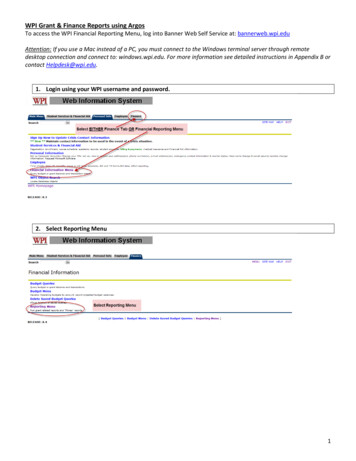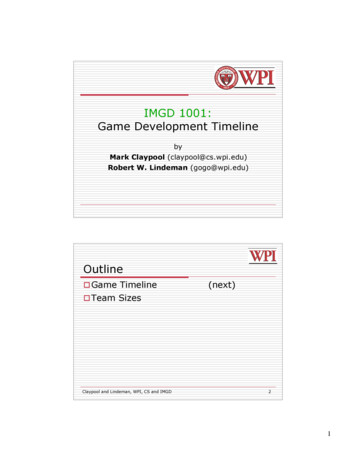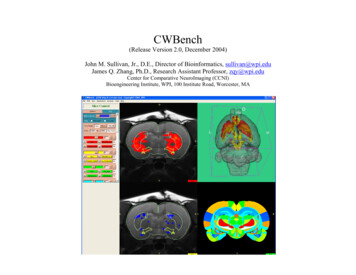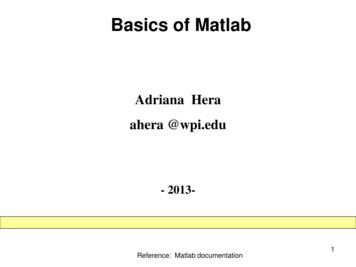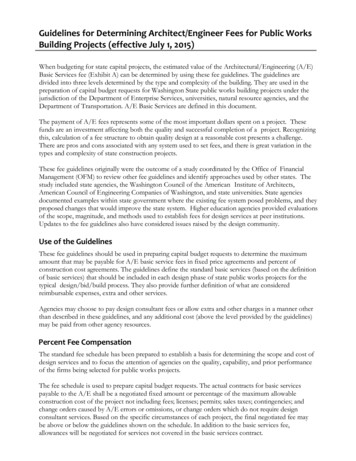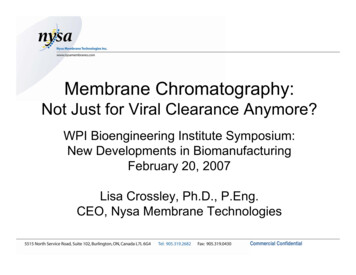
Transcription
Membrane Chromatography:Not Just for Viral Clearance Anymore?WPI Bioengineering Institute Symposium:New Developments in BiomanufacturingFebruary 20, 2007Lisa Crossley, Ph.D., P.Eng.CEO, Nysa Membrane TechnologiesCommercial Confidential
Outline Overview of Membrane Chromatography– Evolution– Current Technology– Recent Advances Applications– Viral Clearance– Disposable Capture Chromatography Constraints Future possibilitiesCommercial Confidential
Evolution of the Technology Membrane chromatography technology evolvedfrom the bioprocessing industry’s need toovercome the mass transfer limitationsassociated with conventional resin-basedchromatography Transport phenomena associated with resinbead chromatography are complex– Fluid stream must be dispersed through the resin bed– Solute must diffuse into the pores within the beads inorder to reach the available binding sites– Complex pore geometry provides additionalresistance to solute transport to the binding sitesCommercial Confidential
Mass Transfer AdvantagesSolute Transport inMembrane vs ResinBead ChromatographySystems:- Dominance ofconvective vs diffusivemass transfer- Convection is asignificantly faster form ofmass transfer thandiffusionCommercial Confidential
Membranes vs Resins Flow distribution is more of a challenge in columns thanin typical membrane configurations Dominance of convective mass transfer in membranestranslates to higher throughputs, resulting in reducedprocessing time and less time in the suite Faster rate of mass transfer in membranechromatography systems means they are able to handlemore concentrated feed streams, reducing the totalbuffer volume required for a given purification step Binding sites in macroporous chromatographymembranes are significantly more accessible for largebiomolecules (viruses, plasmids, large proteins),dramatically increasing binding capacities for thesetargets as compared to an equivalent resin bed where 95% of binding sites are sequestered within the beadsCommercial Confidential
Membranes vs ResinsElectron micrograph of a Sartobind Q membrane and standard chromatographic beadsCommercial Confidential
Membranes vs ResinsSchematic view of viruses binding to functional groups in Sartobind Q membrane poresCommercial Confidential
Current Technology Conventional chromatographic membranes:– Functional groups are covalently linked to porouspolymer microfiltration or ultrafiltration membranes– Large pore sizes of 0.45 – 3.0 μm permit feedstreams to traverse the membranes in convectiveflow resulting in favorable mass transfer rates– High flow rates , throughputs and wide flow rateranges can be accommodated– Very stable binding capacities and excellentresolution across a wide range of flow rates– Loading capacity is typically limited (up to an orderof magnitude lower as compared with packed bedchromatography)Commercial Confidential
Existing Products Pall Mustang , Sartorius Sartobind lines– Cation and Anion Exchange functionalities,Protein A Affinity– 96 well plates, disk filters, capsules, cartridgesCommercial Confidential
Recent Advances Process-Scale Disposable Products– Pall Mustang XT5000 New Membrane Formats– Sartorius Sartobind Direct Novel Composite Technologies– 3M Empore Membranes– Nysa Structured Gel MembranesCommercial Confidential
Process Scale Products Pall Mustang XT5000 5L disposable– Largest chromatography capsule available– Single-use formatCommercial Confidential
New Formats Sartobind Direct– Tangential flow– Intended for direct protein captureCommercial Confidential
Novel Technologies 3M Empore line:– Resin particles embedded in polymeric fibrils– 90% sorbent : 10% PTFE by weight– Two densities available– Standard Density Contains 47 μm particles, high throughput– High Density Contains 12 μm particles, lower throughput Very low elution volumes Clean sample matrices requiredCommercial Confidential
3M Empore Empore Membrane TypesPoly(Styrene Divinylbenzene)Bonded SilicaCommercial Confidential
Novel Technologies Nysa Structured Gel Membranes:– A novel membrane construct consisting of astructured hydrogel formed within a suitablesupportCommercial Confidential
Nysa Membranes Two separate components: a flexible porousnon-woven plastic and a hydrogel– The polymeric support provides mechanicalstrength to the soft hydrogel– The hydrogel determines the properties of thefinal product (pore size, binding chemistry)Flexible poroussupportAnchoredstructured gelCommercial Confidential
Nysa Membranes Key attributes:– Manufactured using GRAS raw materials– Simple, inexpensive fabrication process yieldsproducts that can be cost-effectively deployed assingle use disposables– Supplied gamma-irradiated or ready for sterilizationvia autoclave– Superior binding capacities (5-10x existingchromatographic resins and membranes)– Excellent robustness with respect to mechanicalhandling, performance (consistency)– Inherently hydrophilic, resistant to fouling– Stable to cleaning with NaOH, peracetic acid(Minncare)Commercial Confidential
M.C. Applications Viral Clearance– Existing application– Accepted by FDA / EMEA Disposable Capture Chromatography– Chromatographic membranes have not yetgained widespread acceptance for use incapture purification applications (i.e.purification of target molecule from a givenfeed stream), particularly at process scaleCommercial Confidential
Viral Clearance Both the FDA and the EMEA require the use of at leasttwo orthogonal methods for viral clearance in everymammalian cell-based biopharmaceuticalmanufacturing process– Based on the expectation that different mechanisms ofpurification will provide cumulative performance and thereforebetter ensure product purity and safety– In 2004, BioMarin Pharmaceutical Inc. (Novato, CA) becamethe first company to receive licensure from both the FDA andthe EMEA for a drug product (Aldurazyme ) produced using asequential dual-membrane process for the removal of DNAand viral contaminants Mustang Q and Pall Ultipor (nanofiltration membrane) Anion Exchange membranes that provide an LRV of 6 are accepted for use in Viral Clearance applicationsCommercial Confidential
Disposable ChromatographyThree Key drivers for the adoption ofdisposable chromatography products:1. Increasing regulatory scrutiny oncleaning procedures for re-useable units– Need to reduce risk, limit potential forcross-contamination: Adventitious agentsProtein carry-overCleaning agents– Assays with lower limits of detectionCommercial Confidential
Key Drivers (cont’d)2. Need for novel approaches to productdevelopment and manufacturing forbiopharmaceuticals intended to:– Limit capital expenditures– Enhance flexibility in a givenmanufacturing plant (existing or newconstruction)– Reduce time to clinic and ultimately tomarketCommercial Confidential
Key Drivers (cont’d)3. Increasing availability of complementarydisposable technologies–––––––BioreactorsMixing systemsMedia and buffer bagsTubingConnectorsMF, UF and NF filtersAseptic fill-finish equipmentCommercial Confidential
Constraints Regulatory and economic risks associatedwith the utilization of novel technologies inboth existing and new processes– “There is no good time to innovate. Significantobstacles to implementation of new technologiesexist at every stage of development.” - TomRansohoff, BioProcess Technology Consultants Culture shift– Packed bed chromatography has long been theworkhorse of the Bioprocessing industry. A switchto membrane chromatography for captureapplications represents a significant culture shiftCommercial Confidential
Future Possibilities Inexpensive Affinity Ligands– Synthetic “Protein A”– Camelid antibodies Clarification & Capture– Novel device designs intended to combineculture harvest and primary capture of thetarget molecule into one operation– i.e. a membrane-based alternative toExpanded Bed ChromatographyCommercial Confidential
Summary Membrane chromatography is a valuable technologythat has already gained widespread acceptance forselect applications such as Viral Clearance Advances in membrane chromatography technologyand device design have yielded products suitable foruse in primary capture applications Additional, non-technical obstacles exist to theimplementation of novel membrane chromatographyproducts for primary capture applications Regulatory, economic and competitive pressures maynonetheless drive the adoption of novel membranebased capture purification unit operations in lieu oftheir conventional resin-based counterpartsCommercial Confidential
For more information onMembrane Chromatographyand other advances in thefield of BiopharmaceuticalProcessing Commercial Confidential
Thank You!Lisa CrossleyPresident & CEONysa Membrane Technologies5515 North Service RoadBurlington, Ontario, L7L 6G4Tel: 905-319-2682 x27Fax: 905-319-0430E-mail: crossley@nysamembranes.comCommercial Confidential
Ransohoff, BioProcess Technology Consultants Culture shift – Packed bed chromatography has long been the workhorse of the Bioprocessing industry. A switch to membrane chromatography for capture applications represents a significant culture shift
